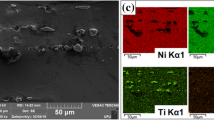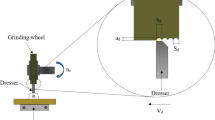Abstract
Nickel-based Inconel 718 stands out from other materials due to its peculiar combination of properties such as high mechanical strength, high hardness, high chemical inertia and low thermal expansion, as well as its ability to operate at high temperatures and in cryogenic conditions. These properties make this material suitable for aeronautic applications, especially for hot structural components, such as blades and discs of aircraft engines in which a high dimensional accuracy and low surface roughness are required. Such manufacturing requirements in general can be achieved through the grinding process. However, due to low thermal conductivity of both the Inconel 718 alloy and the conventional abrasive grinding wheels, most of heat generated during machining concentrates on the workpiece–grinding wheel interface. The usual practice for the removal of heat from grinding zone is by the application of high volume of coolants, but such technique can cause injury to the operator and harm to the environment, if special care with its use and disposal is not taken, which, in turn, increases the cost of the process. Furthermore, due to the poor machinability of Inconel 718, cutting conditions need to be different from those generally employed when grinding steels and cast irons, especially the depth of cut. Within this context, this study presents an approach for determining the grindability of Inconel 718 under different coolant delivery techniques (conventional and minimum quantity lubrication—MQL) and cutting conditions. Grinding tests were also carried out on a grey cast iron material for comparison purposes. Surface roughness, microhardness and surface texture of machined surfaces were the output parameters used to access the grindability of Inconel 718. Results showed that higher values of surface roughness were recorded after grinding the Inconel 718, compared to grey cast iron, thereby indicating the lower grindability of Inconel 718. No evidence of reduction in hardness due to thermal damage was observed after grinding both materials under the established cutting conditions.
Similar content being viewed by others
References
Malkin S, Guo C (2008) Grinding technology: theory and application of machining with abrasives, 2nd edn. Industrial Press Inc, New York
Marinescu ID, Hitchiner M, Uhlmann E, Rowe WB, Inasaki I (2007) Handbook of machining with grinding wheels. CRC Press, New York
Klocke F, Soo SL, Karpuschewski B et al (2015) Abrasive machining of advanced aerospace alloys and composites. CIRP Ann Manuf Technol 64(2):581–604. https://doi.org/10.1016/j.cirp.2015.05.004
Devillez A, Le Coz G, Dominiak S, Dudzinski D (2010) Dry machining of Inconel 718, workpiece surface integrity. J Mater Process Technol 211(10):1590–1598. https://doi.org/10.1016/j.jmatprotec.2011.04.011
Mandal B, Sarkar A, Biswas D, Das S, Banerjee S (2014) An effective grinding fluid delivery technique to improve grindability of Inconel-600. In: 5th international and 26th all India manufacturing technology, design and research conference (AIMTDR 2014), December, IIT Guwahati, Assam, India. https://doi.org/10.13140/rg.2.1.2874.5768
Irani RA, Bauer RJ, Warkentin A (2005) A review of cutting fluid application in the grinding process. Int J Mach Tool Manu 45(15):1696–1705. https://doi.org/10.1016/j.ijmachtools.2005.03.006
Sanchez JA, Pombo I, Alberdi R (2010) Machining evaluation of a hybrid MQL-CO2 grinding technology. J Clean Prod 18(18):1840–1849. https://doi.org/10.1016/j.jclepro.2010.07.002
Walker T (2013) The MQL Handbook. A guide to machining with minimum quantity lubrication, Unist
Malkin S, Guo C (2007) Thermal Analysis of Grinding. CIRP Ann 56(2):760–782. https://doi.org/10.1016/j.cirp.2007.10.005
Klocke F (2009) Manufacturing process 2: grinding, honing, lapping. Springer, Berlin
Maher (2016) Alloy 718 data sheet. http://www.maher.com/media/pdfs/718-datasheet.pdf. Accessed Sept 2016
ASM (1990) Properties and selection—nonferrous alloys and special-purpose materials, vol 2, 10th edn. ASM International Handbook, Russell Township
Ezugwu EO, Bonney J, Yamane Y (2003) An overview of the machinability of aeroengine alloys. J Mater Process Technol 134(2):233–253. https://doi.org/10.1016/S0924-0136(02)01042-7
Ezugwu EO, Wang ZM, Machado AR (1999) The machinability of nickel-based alloys: a review. J Mater Process Technol 86(1–3):1–16. https://doi.org/10.1016/S0924-0136(98)00314-8
API SPEC 6A718 (2004) Specification of nickel-based alloy 718 for oil and gas drilling and production equipment, 1st edn. American Petroleum Institute, Washington D.C.
Kitagawa T, Kubo A, Maekawa K (1997) Temperature and wear of cutting tools in high-speed machining of Inconel 718 and Ti–6Al–6 V–2Sn. Wear 202(2):142–148. https://doi.org/10.1016/S0043-1648(96)07255-9
Zheng H, Liu K (2015) Machinability of engineering materials. In: Nee A (ed) Handbook of manufacturing engineering and technology. Springer, London
Bonney J (2004) High-speed machining of nickel-base, Inconel 718, alloy with ceramic and coated carbide cutting tools using conventional and high-pressure coolant supplies. Ph.D. thesis, London South Bank University, London
Ezugwu EO (2005) Key improvements in the machining of difficult-to-cut aerospace superalloys. Int J Mach Tool Manuf 45(12–13):1353–1367. https://doi.org/10.1016/j.ijmachtools.2005.02.003
Dudzinski D, Devillez A, Moufki A et al (2004) A review of developments towards dry and high speed machining of Inconel 718 alloy. Int J Mach Tool Manuf 44(4):439–456. https://doi.org/10.1016/S0890-6955(03)00159-7
Wenfeng D, Jiuhua X, Zhenzhen C, Honghua S, Yucan F (2010) Grindability and Surface Integrity of cast nickel-based superalloy in creep feed grinding with brazed CBN abrasive wheels. Chin J Aeronaut 23(4):501–510. https://doi.org/10.1016/S1000-9361(09)60247-8
Schultheiss F, Bushlya V, Lenrick F et al (2018) Tool wear mechanisms of pcBN tooling during high-speed machining of gray cast iron. Procedia CIRP 77:606–609. https://doi.org/10.1016/j.procir.2018.08.201
Da Silva RB, Lima MLS, Pereira MF et al (2018) A surface and sub-surface quality evaluation of thee cast iron grades after grinding under various cutting conditions. Int J Adv Manuf Technol 99(5–8):1839–1852. https://doi.org/10.1007/s00170-018-2628-z
Marques A, Suarez MP, Sales WF, Machado AR (2018) Turning of Inconel 718 with whisker-reinforced ceramic tools applying vegetable-based cutting fluid mixed with solid lubricants by MQL. J Mater Process Technol 266:530–543. https://doi.org/10.1016/j.jmatprotec.2018.11.032
Taşliçukur Z, Altuğ GS, Polat Ş, Atapek ŞH, Türedi E (2012) Characterization of microstructure and fracture behaviour of GG20 and GG25 cast iron materials used in valves. In: 21st international conference on metallurgy and materials metal 2012: conference METAL 2012 proceedings, Brno, Czech Republic, EU
Marinescu ID, Rowe WB, Dimitrov B, Inasaki I (2004) Tribology of abrasive machining processes, 1st edn. William Andrew, Norwich
Zeng Q, Liu G, Liu L, Qin Y (2014) Investigation into grindability of a superalloy and effects of grinding parameters on its surface integrity. Proc Inst Mech Eng B J Eng Manuf 229(2):238–250. https://doi.org/10.1177/0954405414526384
Da Silva RB, Lima MLS, Pereira MF et al (2018) A surface and sub-surface quality evaluation of three cast iron grades after grinding under various cutting conditions. Int J Adv Manuf Technol 99:1839. https://doi.org/10.1007/s00170-018-2628-z
Debnath S, Reddy MM, Yi QD (2014) Environmental friendly cutting fluids and cooling techniques in machining: a review. J Clean Prod 83:33–47. https://doi.org/10.1016/j.jclepro.2014.07.071
Kalpakjian S, Schmid R (2009) Manufacturing processes for engineering materials, 5th edn. PE International Edition, New York
Naskar A, Singh BB, Choudhary A, Paul S (2017) Effect of different grinding fluids applied in minimum quantity cooling-lubrication mode on surface integrity in cBN grinding of Inconel 718. J Manuf Process 36:44–50. https://doi.org/10.1016/j.jmapro.2018.09.023
De Oliveira D, Da Silva RB, Gelamo RV (2019) Influence of multilayer graphene platelet concentration dispersed in semisynthetic oil on the grinding performance of Inconel 718 alloy under various machining conditions. Wear 426–427:1371–1383. https://doi.org/10.1016/j.wear.2019.01.114
De Mello AV, Da Silva RB, Machado AR, Gelamo RV, Diniz AE, De Oliveira RFM (2017) Surface grinding of Ti–6Al–4 V alloy with SiC abrasive wheel at various cutting conditions. Procedia Manuf 10:590–600. https://doi.org/10.1016/j.promfg.2017.07.057
ABNT NBR ISO 4287 (2002) Geometrical product specification (GPS)—surface texture: profile method—terms, definitions and surface texture parameters. Brazil
Wang Y, Li C, Zhang Y, Yang M, Li B, Jia D, Hou Y, Mao C (2016) Experimental evaluation of the lubrication properties of the wheel/workpiece interface in minimum quantity lubrication (MQL) grinding using different types of vegetable oils. J Clean Prod 127:487–499. https://doi.org/10.1016/j.jclepro.2016.03.121
Hadad MJ, Tawakoli T, Sadeghi MH, Sadeghi B (2012) Temperature and energy partition in minimum quantity lubrication-MQL grinding process. Int J Mach Tool Manuf 54–55:10–17. https://doi.org/10.1016/j.ijmachtools.2011.11.010
Sharma AK, Tiwari AK, Dixit AR (2016) Effects of Minimum Quantity Lubrication (MQL) in machining processes using conventional and nanofluid based cutting fluids: a comprehensive review. J Clean Prod 127:1–18. https://doi.org/10.1016/j.jclepro.2016.03.146
Williams JA, Xie Y (1992) The generation of wear surfaces by the interaction of parallel grooves. Wear 155(2):363–379
Acknowledgments
The authors are thankful to CAPES, CNPQ and FAPEMIG, as well as to Saint Gobain Abrasives of South America, Villares Metals and Tupy, all Brazilian companies, for supporting this work with the donation of the grinding wheel and workpiece materials, respectively. Rosemar Batista da Silva special thanks the Conselho Nacional de Desenvolvimento Científico e Tecnológico (CNPq) for financial support to this study through the Research Productivity Grant—PQ/2016, Process No. 311337/2016 and Universal demand—Process No. 426018/2018-4.
Author information
Authors and Affiliations
Corresponding author
Additional information
Technical Editor: Adriano Fagali de Souza.
Publisher's Note
Springer Nature remains neutral with regard to jurisdictional claims in published maps and institutional affiliations.
Rights and permissions
About this article
Cite this article
De Oliveira, D., De Paiva, R.L., da Silva, R.B. et al. Assessment of the grindability of Inconel 718 under different coolant delivery techniques. J Braz. Soc. Mech. Sci. Eng. 42, 20 (2020). https://doi.org/10.1007/s40430-019-2093-0
Received:
Accepted:
Published:
DOI: https://doi.org/10.1007/s40430-019-2093-0











